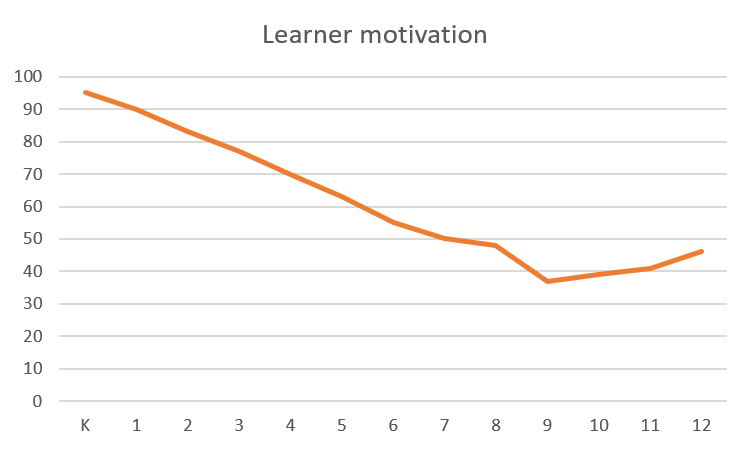With the image below, Michael Fullan shows that student motivation drops dramatically between the start of primary school (K) and the end of secondary school. Marc Prensky about student motivation: “With consistency I can say they’re bored 50-70% of the time”. This is quite a shocking statement since we know that there is a strong correlation between motivation and learning outcomes.

The blog “Children don’t think in subjects”, already indicated that we can tackle problems regarding student motivation with a challenging and adventurous cross-curricular theme.
But how do you create such a theme?
Follow the steps below to create a successful cross-curricular theme, when working with groups and teachers from different disciplines.
1. Brainstorm about the theme
Start by brainstorming about possible promising themes as a group. Let members come up with themes and then select the best one with the following criteria:
- Is the theme suitable for multiple subjects?
- Does the theme appeal to our students?
- Can it include both in-school and out-of-school activities?
- Are divergent assignments (assignments without one correct answer) possible within the theme?
Cross-curricular themes we personally worked with the past year include: “One-way trip to Mars”, “Formula 1”, and “Drinking water”.
2. Create a scenario of learning units
Make sure the scenario fits the theme in a natural way, and think about an introduction and final assignment. For example: “Single trip to Mars” was given a chronological structure and “Drinking water” was subdivided more thematically.
3. Create content for each learning unit and link content to learning objectives
Projects like these work best when the teacher does not offer too much instruction. Give students space to figure assignments out on their own. I learned from Sugata Mitra that broad, divergent open questions provide a much more valuable learning experience for pupils of all ages. So not “What is an insect?”, but “What would happen to Earth if al insects were to disappear?” These questions set a different tone, and will provide completely different learning experiences.
Pupils can search the Internet, conduct a telephone interview with the local water supply company (for the drinking water theme) or set up a Skype session with a world-renowned specialist. Yaacov Hecht, the founder of Democratic Education, also sees the possibility of strongly linked education with the environment of the school and uses the term Education Cities to describe such an environment.
4. Create meaningful final assignments
I prefer when students can choose from a larger variety of assignments, which they prefer to tackle as a group, and that appeal to different types of students. For example: with the Drinking Water theme, students can choose one of the following assignments:
- Water newspaper – Create a newspaper for the drinking water company
- This assignment is reproductive in terms of content, but creative in terms of design and structure
- Water rap – Make a rap focused on responsible water usage by young people
- This assignment requires creativity and persuasiveness, but also offers room for aspects like music, video, and light and sound engineering
- Mini water treatment – Design a working water treatment plant that turns ditch water into drinking water
- A challenging assignment for eager science students
- Own assignment
- or the truly self-managing students
Needless to say, following the steps outlined above does not guarantee success. The project doesn’t have to be perfect all at one. You will regularly change things and keep working with aspects that work well.
Fail fast, succeed faster!
Recommended Literature
- Michael Fullan – Stratosphere, Integrating Technology, Pedagogy and Change Knowledge – Pearson, 2013
- Yaacov Hecht – Democratic Education, the beginning of a story – Innovation culture, 2010
- Sugata Mitra – The child driven education, TedGlobal 2010.
- Marc Prensky – From digital natives to digital wisdom – Thousand Oaks, 2012
More articles on cross-curricular work will be published in the coming weeks. Throughout these articles we will show you examples of how you can approach cross-curricular work using Summario.

Leave a Reply